26
SepGrab Deal : Upto 30% off on live classes + 2 free self-paced courses - SCHEDULE CALL
In this post, we’re going to talk about the installation tableau desktop. As we know it is a development tool by tableau where most of the time developers spend.
Here, we will talk about how to download and install Tableau desktop which is the development tool for the tableau developers. We’re going to cover the following important points in this post -
Different versions of the software
You can see all the releases by Tableau for the desktop tool here - https://www.tableau.com/support/releases
Here you can find all the releases were done by the company for the tool. The major tableau desktop version which was very successful was 10.0 which came into existence in August 2016. Although the earlier versions like 8.x and 9.x were also a big hit and many amazing features were included in that.
Also, if you will look into the list, you’ll find after the version 10.x, Tableau has started releasing new versions with year name as an extension like 2018.x, 2019.x and we expect this to be continued going forward.
The latest addition in the family is 2019.4.1 which has been released on December 19, 2019. If you’re looking to download some specific version, you can click on it and download from the details folder.
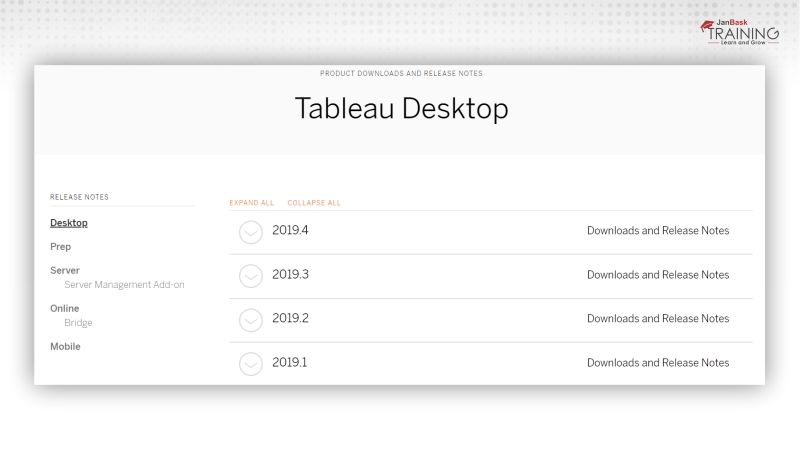
Although while working in the organization, you may find some earlier versions being used. And that’s basically due to the fact that organizations’ first test any new version and when all their measures are fulfilled then only they upgrade the version.
For Windows system, here are the minimum system requirements you have to follow:
For the MAC system, you need to satisfy the following requirements -
Again, the above given configuration is the minimum configuration required for the software to work on your system. But we recommend you have a good configuration like recommended memory is at least around 4 or 8 GB. Else, your system will be too slow and sometimes that can even create hindrance in working of the tool.
Personally, I prefer at least 8 GB memory with at least around 50 GB space and 64-bit processor. This can be a good configuration for the system to work on the tool.
Read: How to Interact with the Content on the Tableau Server?
Tableau Online Training & Certification

You can follow the following URL to download the Tableau desktop -
https://www.tableau.com/support/releases/desktop/2019.4.1
Here you will find the download link, just click on that and i

For Windows, you can download the .exe file and for mAC you can download .dmg file. The size for the windows file is 436 MB while for the MAC system it is 490 MB. Depending on your internet speed, you can download it.
As said above, if you are looking for the older version then you can just browse through the specific version and download as required. Just note, it is recommended to use only one version at a time. Usually, what will happen, when you download and install the new version, existing remains there as it is.
And so, it is recommended to uninstall the older version when you are installing the new version. There will always be a always a risk of technical glitches.
Now as you have already downloaded the software from the official website, it’s time to install it. For Windows operating system user, just double click on the exe file you have downloaded and it will open a window like the below -
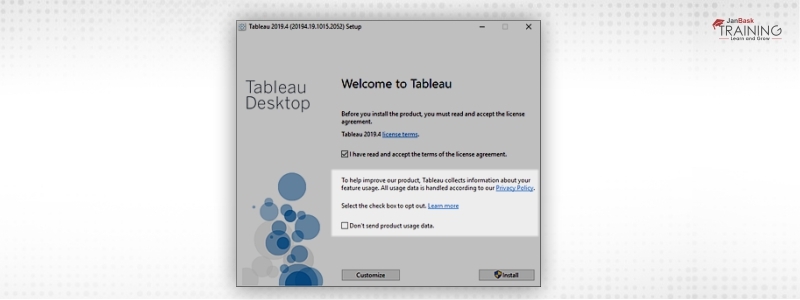
Here you can either select that checkbox or leave it as it. This for the company and if checked, the company will be getting your usage data for improving the product and its configuration. You can even click on the customize button to make more customization which can include the location selection, configuration of the software and more.
For personal uses, I will not recommend selecting the customize option. You can directly either check that checkbox or leave depending on your thought and then click on the install button.
If you will click on customize, you will get a screen something like below -
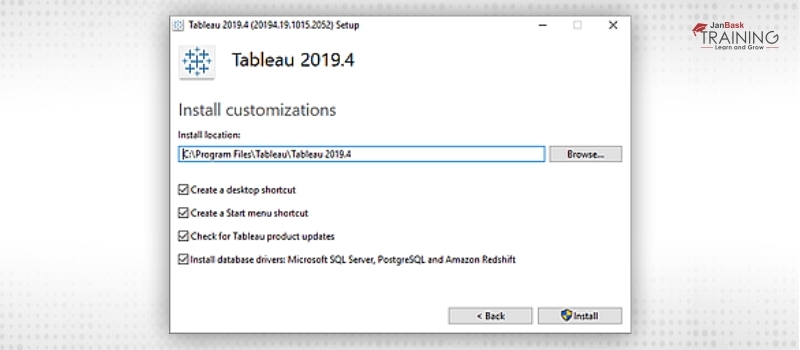
Read: Tableau Server Certification Associate Preparation Guide
As you can see, it says for the custom location of the installation. Means if you want any other location apart from C drive where the software should be installed. Apart from the installation folder, there are many more checkboxes that you can check like if you want to have a shortcut of the software on the desktop, start menu, want to check for product updates and install the databases on the system. Remember all these options will be checked by default and if you don’t want any of these, just uncheck the required checkboxes.
Tableau Online Training & Certification

Once the installation will be finished, you will get a window like below-

This says, either you can start the 14 days of a free trial or you have already bought the license, you can get started now itself. If you don’t have a license available, just click on the required option and then you will get the below screen -
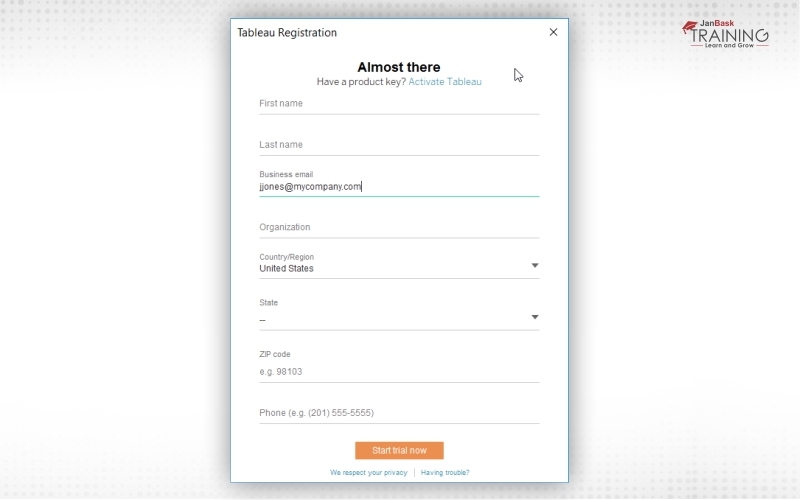
Here you need to fill in the basic details about the software. This will contain your first name, last name, business email id although any email id can work here. So, even if you have the Gmail id or yahoo id, you can register here.
After that, you can enter the company name, state name, country name, zip code, and contact number. Just fill in these details and start on the start trial now button at the bottom. And if you already have the license available then anytime you can click on the activate button or later on, you can enter that by following the help menu.
If you click on the activate button here, it will open a new screen that will have the option to enter the product key.
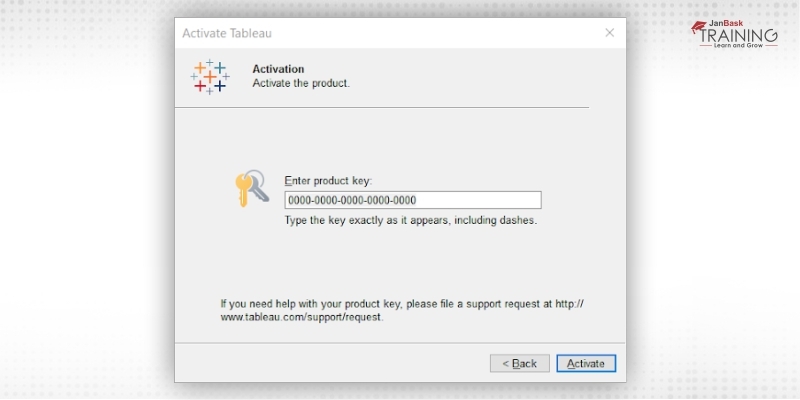
Make sure it copy and paste the product key as you must have received in the email. If due to some region, you are facing issues while activating the license, you may connect with the support team with the exact query and error screenshot.
In general, the below error I have come across a lot while activating the license a lot -

Read: What is Group and How to Implement Grouping in Tableau?
In such cases, you have to ensure that you are connected to the internet and then try again. If the error is still persisting then you are supposed to contact the customer support team.
Earlier, tableau used to sell different products separately but now they are selling as a bundle.
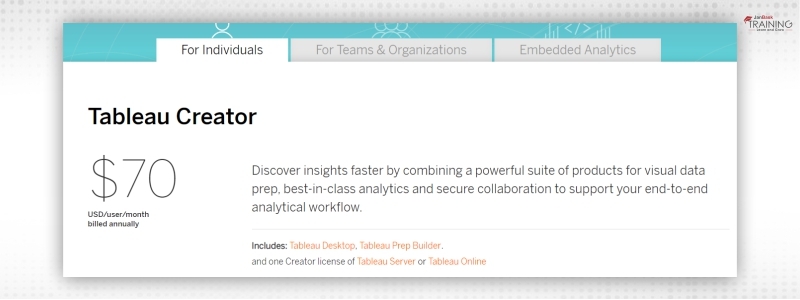
They have 3 license options for all. The first can be useful if you’re using it individually. The second is for teams and organizations, and the third option is to embed analytics.
The pricing starts at $70 per user per month which will be billed annually. This means the billing will be done for the entire year in advance.
In this license, you will be getting the license for desktop, prep building for data preparation, and anyone of server or online. If you want it to be on-premise use the server option else for internet option, it should be online. So, choose the product suits as per the requirement. One best thing I found with the pricing option is, in the same bundle where you get the preparation tool, development tool, and publishing platform.
For teams and organizations, there are different pricing options. Like Tableau creator for $70 per user per month where you get all the tools as shared above. The other option is Tableau explorer which comes at $35 per user per month and in this option minimum, 5 licenses will be required. In this case, you’ll get the explorer license of Tableau server.
The other option is Tableau viewer license which comes at $12 per user per month with a minimum of 100 licenses. Here also you will get the viewer license of the tableau server.
Apart from these, there are add-ons for data management and server which you can also explore depending on the requirement.
Tableau Online Training & Certification

This was all about downloading and installing the tableau desktop. In this post, we talked about the requirements for the installation, pricing of the products for individuals and organizations and the steps involved while installation of the tableau desktop software.
Do try installing the software and let us know if you face any difficulty while doing the installation. Also, while upgrading the software make sure to uninstall the older version and install the new version later to avoid any conflicts.
Read: Tableau Analyst Salary: Every Detail & Factors Affecting
 Pinterest
Pinterest
 Email
Email
The JanBask Training Team includes certified professionals and expert writers dedicated to helping learners navigate their career journeys in QA, Cybersecurity, Salesforce, and more. Each article is carefully researched and reviewed to ensure quality and relevance.

Cyber Security

QA

Salesforce

Business Analyst

MS SQL Server

Data Science

DevOps

Hadoop

Python

Artificial Intelligence

Machine Learning

Tableau
Search Posts
Related Posts
A Complete Guide On Dual Axis
![]() 4.8k
4.8k
6 Steps On How to Build an Impressive Tableau Developer Resumes (With Samples)
![]() 214.6k
214.6k
How To Create A Line Chart In Tableau?
![]() 4.7k
4.7k
Tableau Developer Salary for Beginners & Professionals: 2025 Updated Figures
![]() 6.8k
6.8k
Know Average Tableau Developer Salary for Freshers & Experienced Professionals!
![]() 10.7k
10.7k
Receive Latest Materials and Offers on Tableau Course
Interviews